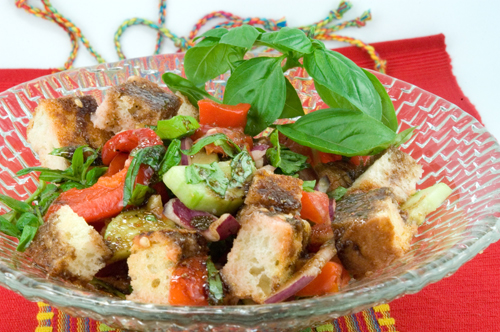
It’s getting toward the end of summer; but it’s still hot out there in some parts. And, honestly, we’re getting tired of salads. So, how can we spice it up? Well, how about panzanella? Right away you can tell from the spelling that it has the word “pan”—which translates to “bread” in Spanish or Italian. And you’d be right. Panzanella is a Tuscan bread salad that is popular in Central Italy, where it is also known as panmolle (pronounced: pan-moh-leh). The salad also includes tomatoes, mint and basil. Although it must be noted that, initially, before the advent of tomatoes, the salad was onion based. And it has a plain dressing of olive oil and vinegar, that’s it.
What’s good about this salad is that you can use day-old bread, even stale bread, if necessary. You see, the bread is toasted in the oven before mixing with the other ingredients. That means the bread doesn’t get squishy like croutons, and its crunchy taste prevails. The recipe given below is a basic panzanella. And the great thing about this is that you can add any other veggies you desire: blanched peas, green beans, fava beans, mushrooms, broccoli, etc. You can even add pieces of ham, salami, or cooked chicken to it. The possibilities are endless.
PANZANELLA
2 cups day-old bread, preferably a good sourdough or crusty baguette, torn or cut into 1-inch pieces
2 medium tomatoes, diced
1 medium zucchini, cut into 1/4-inch ring, and then each ring cut in half
1 small red onion, peeled and thinly sliced
3 cloves garlic, peeled and finely minced
1/2 cup fresh mint, washed, dried, and roughly torn
1/2 cup fresh basil, washed, dried, and julienne
1/2 cup fresh dill, washed, dried, and roughly chopped
Handful fresh Italian parsley, washed, dried, and chopped
1/3 cup extra virgin olive oil
1/4 cup red wine vinegar
Salt and ground black pepper to taste
1. Preheat oven to 375 degrees F.
2. Spread bread out on a baking sheet or pan and bake until golden, about 14 minutes, flipping once halfway. Then let cool.
3. In a large bowl, toss together the bread pieces, tomatoes, zucchini, onion, garlic, mint, basil, dill, and parsley.
4. In a small bowl, mix olive oil, vinegar, salt and pepper. Pour over bread salad, Toss. Adjust seasonings, if necessary; and let stand for at least one hour for flavors to blend before serving.
Yield: 4-6 servings.
photo: courtesy of a foodie affair







